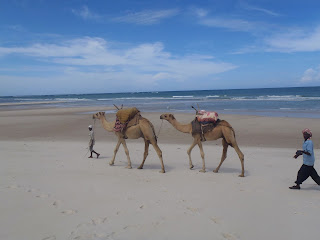So before I begin my second part of my
holiday, I'd like to take a moment to put Kenya's transportation into
perspective.
Before we dissect the nature of the
buses and matatus, the medium to which they travel upon needs
clarification. Kenya's roads are the furthest thing from an
interstate in the States. The best road you may ride upon will still
be littered with potholes and can make the strongest stomach nauseated.
Furthermore, if it's the “best” road, that means
approximately ¼ of Kenya's population will be simultaneously driving
on that same stretch of road. Insanely dense congestion, total
disregard of “rules of the road” (which honestly I don't think
exists as a saying here), and dreadfully close encounters with death
are all common occurrences.
However, there is respite from the
concrete jungle commute! Head into the beautiful country hills, the
vast stretches of Rift Valley plains, the inner “bush” of Kenya
and there isn't another vehicle to be seen for miles. But there is a
price to be paid for such tranquility...and that price is manifested
as the worst roads in the world. Tarmac is just a
wishful thought. Inaccurate to even call them potholes, small craters
make up the majority of the road surface (everyone tested their
center of gravity, tilting upwards of 20 degrees...with plenty of
turned over trucks to display tipping points). Cows and goats dictate
the traffic patterns.
Next, one must ask, “What kind of
incredible vehicles can make such a journey.”
Answer: beat to hell
Nissan buses and war-torn matatus.
Matatu definition:10 passenger van equivalent to which approximately 20 people are squeezed into. They are usually painted bright colors, boast all sorts of slogans (Messiah; Big Daddy; Amoeba Frank; Big Wet....the list goes on), and of course have the loudest techno/reggae theme music.
 |
| While trying to find a worthy picture of matatu... I found this cartoon that basically sums it up |
 |
| Mombasa driving the 99% |
My favorite experience was riding from
the Diani-Mombasa ferry to Diani junction, approximately a 30 minute
ride. I find one matatu going where I need, however it's already
jam-packed. “No worry, brotha!” is the “all aboard!” I slam
myself into the middle of the pack, backpack on some old Muslim guy's
lap, my face squashed into his traditional kufi (hat), holding onto
him and a nearby mother so I wouldn't be catapulted out the door
(which my rear end was hanging out of already.)
P.S. CMMB, I'm sorry you have to read
this. I PROMISE I'm taking all necessary precautions.
Anyways, the Matatu was this neon pink
tank with honestly 22 people aboard and Dragostea Din Tei (better
known as the Numa Numa song) BLASTING. While careening down the
road (remember how the roads are), I'm begging the good, sweet
Lord to get me there. I turn my head out of the kufi and find my
other handhold (mother) full on breast feeding. Now this is an
experience.
Aside from matatu madness, those
previously mentioned Nissan buses hold their own adventure.1 in 5,000
buses are comfortable and most likely to pass department of
transportation standards. On my 28 hour bus journey home from Lamu,
I was fortunate enough to ride upon Vanga express (who I think touted
“Masha'Allah” on the windshield). Whether burnt by cigarettes,
stained from God knows what, or completely dismantled, each seat
proudly showed its battle scars from overland Kenyan travel. My
actual assigned seat had no back and a neighboring seat back was
suspended from the overhead luggage racks with a rope. Nice, a swing!
Additionally, you could study the exposed, intricately welded frame
of the bus and muse on how well it would hold upon roll over.
 |
| Beater bus I was lucky enough to ride on. |
 |
| Getting you there on a prayer! |
Needless to say, the ride was memorable. Standing room only, people sitting on old crates of Coca Cola or burlap bags filled with produce, stopping every 15 miles to pick up another passenger who loaded maize, doors, huge bundles of charcoal, tires, wicker furniture into the bottom or on top of the bus.
 |
| We have plenty of room! |
I can't complain however because I
spent less than 20 dollars for a round trip, cross country bus ride
(approx 1000 miles). I also, as my dad puts it, I got exactly what I
paid for! Thank you Kenya for the amazing experience.


























